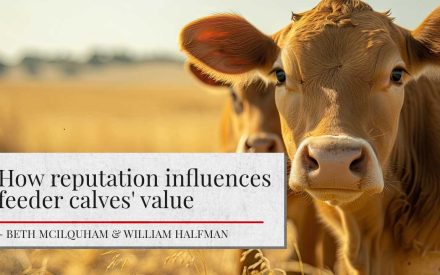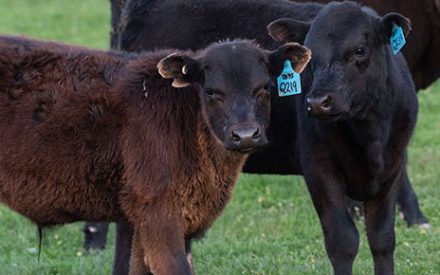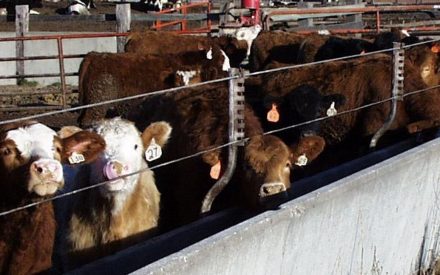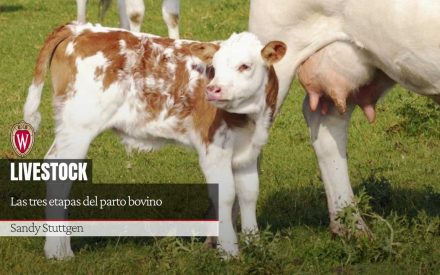Preconditioning calves is not a new or groundbreaking concept within the cow-calf industry and is a management practice that many producers implement to increase buyer interest and add value to their feeder calves. Preconditioning is the practice of building the health status of calves and training them to feed bunks and waterers post weaning. Preconditioning is a relatively loose term because there is no one standardized program. True preconditioning should include a combination of weaning, vaccination, castration, dehorning, and feed bunk and water training. Specific vaccinations administered and time periods may vary. Feeder calves weaned for a minimum of 45 days have been shown to experience less morbidity and lower health care costs per steer than calves weaned and immediately shipped regardless of vaccination protocol on the ranch (Step et al, 2008). Just “giving them their shots” is not preconditioning.
Cattle buyers value knowing a group of calves is at lower risk for disease (morbidity) and death (mortality) because they have been through a quality preconditioning program (Schumacher, Schroeder, and Tonsor, 2012).
Value of Preconditioning
A well-planned preconditioning program includes the calves’ nutritional and health needs and the operation’s marketing goals. What is included in a preconditioning program? provides more information about such programs. Branded preconditioning programs have specific required procedures, including timing relative to time of sale. Several programs include the number 45 in the name indicating that the calves have all been weaned at least 45 days prior to sale. Schumacher, Schroeder, and Tonsor (2012) analyzed data from a feedlot producer survey that expressed feedlot producers willingness to pay $4.84/cwt more for a calf under the same health program weaned 45 days as compared to 30 days, and $10.22/cwt for calves with the same health program that were not weaned at the point of sale.
Forty-five day preconditioning programs often result in producers selling heavier calves – more pounds of calf per cow. Increased weight per calf may come from owning the calves longer, and more closely meeting their nutritional needs when looking at the potential quality of late season pasture and reduced milk production of the dam compared to eating a balanced ration to meet a target rate of gain during the weaning and preconditioning period. We do not want to make the calves over conditioned during preconditioning. The goal is to add frame and muscle, not fat.
Thinking beyond the health benefits, preconditioning is also a more humane way of operating. Anyone who has walked the alleys of a sale barn during the fall weaning season can spot the groups of calves missing their mothers and those that are probably hungry and thirsty due to the lack of feed bunk and water access training. In this day and age, consumers are becoming more and more concerned with animal welfare, and this begins well before the calves step foot into a feedlot.
Selling vs. Marketing
Cattle buyers and feedlot operators are looking for specific types of cattle that best fits their needs. These needs include properly vaccinated, dehorned, castrated (and healed), weaned, bunk and waterer trained and backgrounded cattle at a particular weight and body condition. Buyers may still bid on calves falling outside of these needs, but at lower prices to mitigate the risk non- preconditioned calves face.
Obtaining a favorable price requires the producer to move from just ‘showing up at the sale’ with calves to helping your marketing partner promote your calves. It is up to the producer to both provide a favorable product and help proactively market it as such. Correctly preconditioning is one part of the equation to increase interest in your calves, but only if the preconditioning program is shared with potential buyers. This is done by providing the sale barn with documentation of how the calves have been prepared to perform for the next owner. Some markets have forms for feeder cattle consigners to use. It is important to provide this information to the sale barn before sale day, as many sale barn locations will advertise the calves, including precondition status, in the early listings, further helping to promote and market the cattle. Another reason to let sale barns know ahead of time what you are bringing is they are often asked by buyers how many head they expect at sales, and the more head, the more likely buyers are to attend because they know they have a greater chance of filling loads.
Building a Favorable Reputation
Preconditioning every year helps establish your reputation. Many feeders track the source and performance of cattle they buy from year-to-year. If your cattle consistently do well for buyers you build a reputation of producing a high-quality product and become a sought after source for feeder calves.
The health and productivity of the calves your operation produces influences your reputation at the sale barn. By marketing properly preconditioning calves, a producer is not only setting their feeder calves up for success on sale day this year but also helping build demand for their calves in the years to come. Building and maintaining a positive reputation for the farm, themselves, and their cattle, allows cattle producers to be preferred sources of feeder calves and help build and maintain consumer confidence.
References
Schumacher, T., T.C. Schroeder, and G.T. Tonsor. “Willingness-To-Pay for Calf Health Programs and Certification Agents.” Journal of Agriculture and Applied Economics 44,2(May 2012):191-202.
Step, D. L; Krehbiel, C. R; DePra, H. A; Cranston, J. J; Fulton, R. W; Kirkpatrick, J. G; Gill, D. R; Payton, M. E; Montelongo, M. A; Confer, A. W. “Effects of commingling beef calves from different sources and weaning protocols during a forty-two-day receiving period on performance and bovine respiratory disease1,2.” Journal of Animal Science, 2008-11-01, Vol.86 (11), p.3146
Download Article

 How reputation influences feeder calves' value
How reputation influences feeder calves' value Preconditioning Tools Available
Preconditioning Tools Available Preplan Preconditioning Tasks
Preplan Preconditioning Tasks Las tres etapas del parto bovino
Las tres etapas del parto bovino


